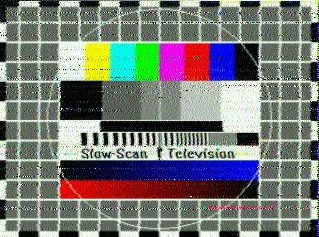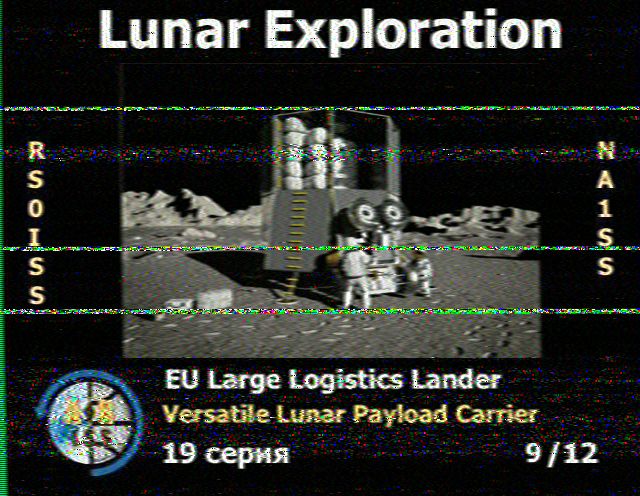Slow-Scan Television (SSTV) has been around in ham radio for 50+ years. Initially, SSTV required expensive and complicated equipment, but thanks to computers and today’s digital modes, it’s easier than ever to start experimenting with one of ham radio’s oldest specialty modes!
How do you get started with SSTV? Read on!
What Is SSTV?
SSTV takes a static (non-moving) image and “scans” it from right to left and top to bottom, and transmits the image in three primary colors using audio frequencies (in the same bandwidth as a voice transmission). Because it uses just audio frequencies, any radio that can transmit and receive voice can also transmit and receive SSTV. That means you can use your HF radio, or your VHF mobile, or your VHF HT to send and receive SSTV! There are several popular “modes”, which vary in scan time and image resolution. Needless to say, there is a tradeoff between image speed and resolution – one of the popular modes is “Robot36” which transmits a single image in 36 seconds.
How Do I Get Started?
If you have an interface between your computer and radio for digital modes (FT-8, BPSK, etc.), that interface should work for SSTV. Download and install SSTV software (see right) and configure to see the audio source for your interface. Most software supports “templates” where you can add overlays to images for CQ and your callsign or freeform text. There’s usually plenty of SSTV activity to receive on 14.230 MHz on evenings and weekends.
For VHF/UHF radios (for ISS SSTV), most mobile radios have a “data” port on the back of the radio that you can interface with. If you just want to receive, you can use the Ext. Speaker jack with a sound card audio interface (verify levels first). You will also need to track the ISS orbits to know when the ISS will be overhead (highest apogee passes are best).
Even if you don’t have a wired interface, you can still have fun with SSTV. You can use smartphone apps to send and receive SSTV images, just by holding the phone up to your radio microphone or speakers (audio coupling) – it works best in a quiet room.
RWK SSTV Events
- QRV Tech – December 2024 – Learn How To Model AntennasIf you’ve ever wanted to dabble in modeling antennas (but were afraid to try), then don’t miss tomorrow night’s QRV. I’ll be talking about MMANA (Macoto Mori’s ANtenna Analyzer) which is a free, easy-to-use-once-you-understand-it software…and my goal for tomorrow night is to get you to a point where you can model antennas after watching the…
Read more - QRV Tech – November 2024 – A Closer Look at SSTVOn the heels of another SSTV Event from the International Space Station, our November 2024 QRV Tech program will take a deeper look at the Slow-Scan TV Mode, how it works, and how you can use it on both HF and VHF/UHF. It’s a fun mode and has been around a long time, and it’s…
Read more - ARISS SSTV Event – Nov 11-18, 2024By Chip Coker KD4C After an extended outage due to equipment failure, the ability of the ARISS (Amateur Radio on the International Space Station) to send SSTV is back! Welcome Back SSTV! Amateur Radio on the International Space Station (ARISS) announces an SSTV event scheduled to begin on Monday, November 11 at 11:50 UTC and…
Read more - General Meeting – November 2024 – Annual Show & Tell Night + SSTV EventPlease join RWK on Monday Nov 11th for our General Meeting. If it’s November, then that means it’s time for our annual Show & Tell Night, where RWK Members show off small projects or radio-related items that they have worked on. We want to have 5-6 projects to show (5-10 minutes each). You may come…
Read more - ARISS SSTV Experiment – Oct 8-14, 2024By Chip Coker KD4C After an extended outage due to equipment failure, the ability of the ARISS (Amateur Radio on the International Space Station) to send SSTV is back (hopefully)! At long last, the ARISS Team is conducting tests of the SSTV system for the next few days. Welcome Back SSTV! The test is scheduled…
Read more

SSTV on HF
SSTV is used on all HF bands, but use is concentrated primarily on 20M (14.230MHz), where you can hear activity at all times of the day or night.
SSTV on VHF
SSTV is also possible on VHF/UHF FM (either through a repeater or simplex). You must be aware of the transmit time for images so that you don’t stress or time out your radio (or a repeater). Because it’s FM, SSTV images are fairly clear.
SSTV on the ISS
The International Space Station has SSTV generation capability and periodically will conduct SSTV events for up to a week at a time. You can obtain a nice certificate from the ARISS project for uploading a received image from the ISS. Check the ARISS page for the latest news and what’s currently operational: https://www.ariss.org/current-status-of-iss-stations.html

Popular SSTV Software
MMSSTV (Windows)
QSSTV (Linux)
CQ SSTV (iPhone)
Robot36 (Android)
